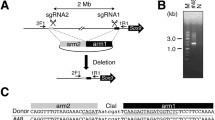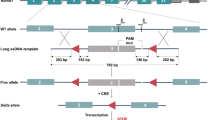Abstract.
The Del(13)Svea36H deletion was recovered from a radiation mutagenesis experiment and represents a valuable resource for investigating gene content and function at this region of mouse Chromosome (Chr) 13 and human Chr 6p21.3-23 and 6p25. In this paper we examine the physical extent of chromosome loss and construct an integrated genetic and radiation hybrid map of the deleted segment. We show that embryos which are homozygous for the deletion die at or before implantation and that heterozygotes are subviable, with a substantial proportion of carriers dying after mid-gestation but before weaning. The majority of viable carriers exhibit a variety of phenotypes including decreased size, eyes open at birth, corneal opacity, tail kinks, and craniofacial abnormalities. Both the heterozygous viability and the penetrance of the visible phenotypes vary with genetic background.
Similar content being viewed by others
Author information
Authors and Affiliations
Additional information
Received: 14 March, 2001 / Accepted: 7 May 2001
Rights and permissions
About this article
Cite this article
Arkell, R., Cadman, M., Marsland, T. et al. Genetic, physical, and phenotypic characterization of the Del(13)Svea36H mouse. Mammalian Genome 12, 687–694 (2001). https://doi.org/10.1007/s00335-001-2066-2
Published:
Issue Date:
DOI: https://doi.org/10.1007/s00335-001-2066-2




